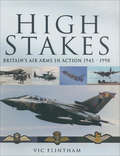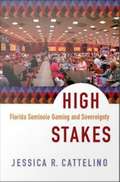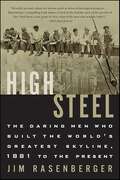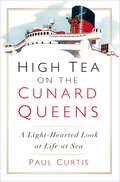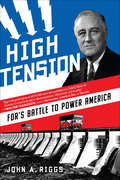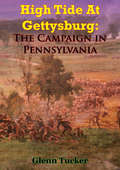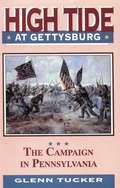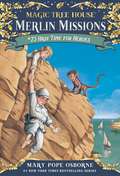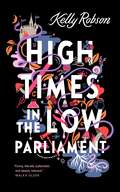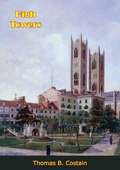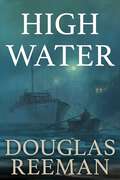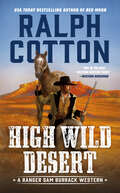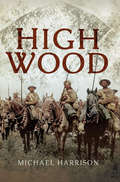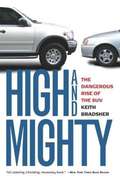- Table View
- List View
High Stakes: Britain's Air Arms in Action, 1945–1990
by Vic FlinthamAfter the dust of World War II had settled, the military position of the UK was far from straightforward. It was of course allied to the USA and part of NATO, but it was at odds with the former in maintaining an Empire and the two nations also had competing oil interests in the Middle East. The UK's engagement in war after 1945 was thus a strange mixture ranging from homeland security through insular actions within the colonies or protectorates to preserve empire - to playing a major role in confronting the USSR. The types of active involvement of the RAF, Fleet Air Arm and Army Air Corps between 1945 and 1995 include the following, with examples.Maintaining Local Stability - Greece, Netherlands East Indies. Maintaining Empire - Malaya, Kenya. Defending Empire - Borneo. Defending Interests - Suez, Kuwait. Homeland Security - Northern Ireland, air defence. Confrontation - Berlin Airlift, Korea. Covert Action - Albania, strategic reconnaissance. Humanitarian and Peacekeeping- Jordan, Cyprus. Development of Deterrent - Bombs, bombers and missiles.
High Stakes: Florida Seminole Gaming and Sovereignty
by Jessica R. CattelinoIn 1979, Florida Seminoles opened the first tribally operated high-stakes bingo hall in North America. At the time, their annual budget stood at less than $2 million. By 2006, net income from gaming had surpassed $600 million. This dramatic shift from poverty to relative economic security has created tangible benefits for tribal citizens, including employment, universal health insurance, and social services. Renewed political self-governance and economic strength have reversed decades of U. S. settler-state control. At the same time, gaming has brought new dilemmas to reservation communities and triggered outside accusations that Seminoles are sacrificing their culture by embracing capitalism. In High Stakes, Jessica R. Cattelino tells the story of Seminoles' complex efforts to maintain politically and culturally distinct values in a time of new prosperity. Cattelino presents a vivid ethnographic account of the history and consequences of Seminole gaming. Drawing on research conducted with tribal permission, she describes casino operations, chronicles the everyday life and history of the Seminole Tribe, and shares the insights of individual Seminoles. At the same time, she unravels the complex connections among cultural difference, economic power, and political rights. Through analyses of Seminole housing, museum and language programs, legal disputes, and everyday activities, she shows how Seminoles use gaming revenue to enact their sovereignty. They do so in part, she argues, through relations of interdependency with others. High Stakes compels rethinking of the conditions of indigeneity, the power of money, and the meaning of sovereignty.
High Steel: The Daring Men Who Built the World's Greatest Skyline, 1881 to the Present
by Jim RasenbergerA powerful first-hand account of the many generations and ethnic groups of men who have built America's skyscrapers.From the early days of steel construction in Chicago, through the great boom years of New York city ironwork, and up through the present, High Steel follows the trajectory of careers inextricably linked to both great accomplishment and catastrophic disaster. The personal stories reveal the lives of ironworkers and the dangers they face as they walk across the windswept, swaying summits of tomorrow's skyscrapers, balanced on steel girders sometimes only six inches wide. Rasenberger explores both the greatest accomplishments of ironwork—the vaulting bridges and towers that define America's skyline—and the deadliest disasters, such as the Quebec Bridge Collapse of 1907, when 75 ironworkers, including 33 Mohawk Indians, fell to their deaths. High Steel is an accessible, thrilling, and vertiginous portrait of the lives of some of our most brave yet unrecognized men.
High Street: Book Two in the gripping, uplifting Gibson Family Saga
by Anna Jacobs**Book two in the gorgeously heartwarming Gibson Family series, perfect for fans of Catherine Cookson, Dilly Court and 'Call the Midwife'**Lancashire, 1845. Annie Gibson can finally leave Salem Street. At long last she's realised her dream of opening an elegant dressmaking salon in the mill town of Bilsden - and she is determined to take her father and his second family with her, away from poverty. But Annie's troubles are far from over. Someone is trying to undermine her business; her family have their own ideas about what they want to do with their lives; and several men are persistently trying to win her favour, including Frederick, the mill owner, and Daniel, her childhood friend.As Annie gets better acquainted with both, she becomes increasingly confused about her feelings. Can she really be in love? And can she risk trusting any man ever again?**************Praise for Anna Jacobs: 'Catherine Cookson fans will cheer!' - Peterborough Evening Telegraph'Anna Jacobs' books are deservedly popular. She is one of the best writers of Lancashire sagas around' - Historical Novels Reviews'Anna Jacobs' books have an impressive grasp of human emotions' - Sunday Times
High Street: Book Two in the gripping, uplifting Gibson Family Saga (Gibson Saga #2)
by Anna Jacobs**Book two in the gorgeously heartwarming Gibson Family series, perfect for fans of Catherine Cookson, Dilly Court and 'Call the Midwife'**Lancashire, 1845. Annie Gibson can finally leave Salem Street. At long last she's realised her dream of opening an elegant dressmaking salon in the mill town of Bilsden - and she is determined to take her father and his second family with her, away from poverty. But Annie's troubles are far from over. Someone is trying to undermine her business; her family have their own ideas about what they want to do with their lives; and several men are persistently trying to win her favour, including Frederick, the mill owner, and Daniel, her childhood friend.As Annie gets better acquainted with both, she becomes increasingly confused about her feelings. Can she really be in love? And can she risk trusting any man ever again?**************Praise for Anna Jacobs: 'Catherine Cookson fans will cheer!' - Peterborough Evening Telegraph'Anna Jacobs' books are deservedly popular. She is one of the best writers of Lancashire sagas around' - Historical Novels Reviews'Anna Jacobs' books have an impressive grasp of human emotions' - Sunday Times
High Street: Book Two in the gripping, uplifting Gibson Family Saga (Gibson Saga #2)
by Anna JacobsThe second in the heartwarming Lancashire saga series that began with SALEM STREET, by beloved author Anna Jacobs.In 1845 Annie Gibson can finally leave Salem Street. Her dreams of being able to open an elegant dressmaking salon in the High Street of Bilsden, a Lancashire mill town, have come true. And she is going to take her father and his second family with her, away from poverty, away from the Rows.But Annie has not left trouble behind. Someone is trying to undermine her business. Her family have their own ideas about what they want to do with their lives. And several men are persistently trying to win favour with the beautiful young widow - including Frederick Hallam, the mill owner, and Daniel O'Connor, her childhood friend.As Annie gets better acquainted with both, she becomes increasingly confused about her feelings. Can she really be in love And can she risk trusting any man again. (P) 2021 Hodder & Stoughton Ltd
High Strung: Bjorn Borg, John McEnroe, and the Untold Story of Tennis's Fiercest Rivalry
by Stephen Tignor“A book full of aces....A true page-turner.”—Associated Press“This is good stuff, and it’s written with flair.”—The OregonianHigh Strung by Stephen Tignor is the gripping untold story of the fiercest rivalry in the history of professional tennis. Viewed through the lens of the fabled 1981 U.S. Open match between Bjorn Borg and John McEnroe, High Strung brings the golden age of tennis vibrantly alive once more. A fascinating chronicle that orbits around the four greatest, most enigmatic talents in the sport at the time—McEnroe, Borg, Jimmy Connors, and Vitas Gerulaitis—High Strung is a superior sports history, a must read for anyone who truly loves the game.
High Tea on the Cunard Queens: A Light-Hearted Look at Life at Sea
by Paul CurtisThis amusing insight into Cunard’s legendary liners begins more than fifty years ago when the author joined the original Queen Mary as an entertainments officer, when a part of the job was ‘bumbling’ the passengers while keeping a wary eye out for professional gamblers criss-crossing the Atlantic, and there was bingo and dance bands, novelty dancing and fancy-dress parades, and a primitive disco with a monster juke box. Paul Curtis recounts the stories of the ships, the antics of passengers and crews, and much more besides. Just turning these pages releases a sniff of the sea and a whiff of champagne. This frank and funny account of mixes Cunard history with personal anecdote and vividly reveals how passenger and crew life have changed over the years across the Cunard liners.
High Tension: FDR's Battle to Power America
by John A. RiggsAn account of Franklin Roosevelt&’s battle against the power industry to bring electricity to rural communities in the United States. When Franklin Delano Roosevelt took office in the depths of the Depression, high tension―or high voltage―power lines had been marching across the country for decades, delivering urban Americans a parade of life-transforming inventions from electric lights and radios to refrigerators and washing machines. But most rural Americans still lived in the punishing pre-electric era, unconnected to the grid, their lives consumed and bodies broken by backbreaking chores.High Tension is the story of FDR&’s battle against the &“Power Trust,&” an elaborate Wall Street-controlled web of holding companies, to electrify all of America―even when the corrupt captains of the industry and their cronies (led by a formidable and honest champion, Wendell Willkie, whose role in the battle propelled him to a presidential bid to unseat Roosevelt in 1940) cried that running lines to rural areas would not be profitable and that in a free market there would simply have to be a divide between the electricity haves and have-nots. Roosevelt knew better. And in this story of shrewd political maneuvering, controversial legislation, New Deal government organizations like the Tennessee Valley Authority, the packing of Federal courts, towering business figures, greedy villains, and the crying needs of farmers and other rural citizens desperate for services critical to their daily lives, John A. Riggs has chronicled democracy&’s greatest balancing act of government intervention with private market forces. Here is the tale of how FDR&’s efforts brought affordable electricity to all Americans, powered the industrial might that won World War II, and established a model for public-private solutions today in areas such as transportation infrastructure, broadband, and health care.Praise for High Tension &“The little known but captivating story of electricity is at the heart of the New Deal. John A. Riggs is the perfect person to tell the tale.&” ―Walter Isaacson, author of The Innovators, Leonardo da Vinci, and Steve Jobs &“[A] lucid and compelling tale. This is a fresh angle of vision on one of the most important and under-appreciated stories of the first half of the 20th century.&” ―Jonathan Alter, author of The Defining Moment: FDR&’s Hundred Days and the Triumph of Hope &“An innovative history of the chaos and conniving that created America&’s transformative electricity system. . . . A compelling read. Thoroughly researched and gracefully written. . . . A must for historians, it is also a gripping read for all.&” ―Martin J. Sherwin, Pulitzer Prize-winning co-author of American Prometheus: The Triumph and Tragedy of J. Robert Oppenheimer &“[A]n exhaustive look at President Franklin Roosevelt&’s multipronged war against the private utility sector. . . . Riggs dives deep into the legislative, judicial, and public opinion battles over Roosevelt&’s energy initiatives, including the Tennessee Valley Authority, and argues that the hybrid public-private system that emerged in America was critical to the nation&’s &“economic global supremacy&” during and after WWII. . . . [T]his authoritative account is a valuable resource for students of America&’s energy policy.&” ―Publishers Weekly
High Tide At Gettysburg: The Campaign In Pennsylvania
by Glenn Tucker""Gettysburg had everything," Henry S. Commager recently wrote. "It was the greatest battle ever fought on our continent; it boasts more heroic chapters than any other one battle. It was the high tide of the Confederacy."This is the way Glenn Tucker has always seen it and this is the way he reports it in High Tide at Gettysburg. The story of Gettysburg has never been told better, perhaps never so well as in this volume. Glenn Tucker has the immediacy of a war correspondent on the spot along with the insights that come from painstaking research. The armies live again in his pages.In his big, generous book Glenn Tucker has room to follow Lee's army up from Chancellorsville across Maryland into Pennsylvania. With Jackson recently killed, Lee had revamped his top command.When Meade's men caught up with the Confederates and the two armies were probing to locate each other's concentrations, Mr. Tucker's account becomes sharper, more dramatic. His rapidly moving, vivid narrative of the three-day battle is filled with fascinating episodes and fresh, stimulating appraisals.Glenn Tucker is akin to Ernie Pyle in his interest in people. With him you meet Harry King Burgwyn, "boy colonel" of the 26th North Carolina, just turned twenty-one, who slugged it out with Col. Henry A. Morrow of the 24th Michigan until few survived on either side. You feel the patriotic surge of white-haired William Barksdale, who led his Mississippians on the "grandest charge of the war" and died as he broke the Federal line. You sense the magnetism of Hancock the Superb, and feel the driving power of rugged Uncle John Sedgwick as he hurried his big VI Corps to the battlefield. With Old Man Greene you struggle in the darkness to save the Culp's Hill trenches. And much more. Mr. Tucker weaves in many sharp thumbnail biographical sketches without slowing the action. Many North Carolinians, previously slighted, here receive their due.Full, dramatic, immediate, here is Gettysburg."
High Tide at Gettysburg: The Campaign in Pennsylvania
by Glenn TuckerThe author tries to present how the Gettysburg battle was won and lost, and why the Gettysburg campaign remains such an appealing study to large numbers even after the passing of nearly a century.
High Tide at Noon
by Elisabeth OgilvieYoung, vivacious Joanna Bennett desperately wishes to be captain of her own lobstering boat, but despite being the favored daughter of Bennett&’s Island&’s founding family, she is still just a girl in the eyes of the community, and a girl living off the coast of Maine in the early 20th century is expected to mind the kitchen, not tend to pot buoys. While quietly struggling to find her place on insular Bennett&’s Island, one where she could let her bold and opinionated nature shine without shaming her family, Joanna instead finds love when she meets a witty stranger with a sparkling smile just off the mailboat. One whirlwind courtship and wedding later, Joanna finds herself master of her own house, and every aspect of her beloved island seems to reflect her joy. But when the luster begins to wear off and her husband&’s dark secrets slowly reveal themselves, Joanna must draw on her determination, resilience, and resourcefulness to keep her family together.This evocative coming-of-age story transports readers to the beautiful and rugged Maine coast, where families must eke their livelihoods from the tempestuous ocean but in return they&’re afforded the daily splendor and simple pleasures of island life.
High Time for Heroes
by Mary Pope Osborne Sal MurdoccaThe #1 bestselling chapter book series of all time celebrates 25 years with new covers and a new, easy-to-use numbering system!Jack and Annie are on a mission for Merlin the magician! This time, the magic tree house whisks them off to Thebes, Egypt, to find Florence Nightingale, a world-famous nurse. But when they find her, the Florence Nightingale they meet is not a famous nurse at all—she’s not even a regular nurse! Have they found the right person? Or did Merlin make a mistake? An easy mission turns dangerous when Jack and Annie try to solve the mystery!Formerly numbered as Magic Tree House #51, the title of this book is now Magic Tree House Merlin Mission #23: High Time for Heroes.Did you know that there’s a Magic Tree House book for every kid?Magic Tree House: Adventures with Jack and Annie, perfect for readers who are just beginning chapter booksMerlin Missions: More challenging adventures for the experienced readerSuper Edition: A longer and more dangerous adventureFact Trackers: Nonfiction companions to your favorite Magic Tree House adventuresHave more fun with Jack and Annie at MagicTreeHouse.com!
High Time for Heroes (Magic Tree House Merlin Missions #23)
by Mary Pope Osborne Sal MurdoccaMagic Tree House #51: High Time for Heroes features Jack and Annie back in Egypt, still seeking the secrets of greatness for Merlin. This time they will meet the great nurse, Florence Nightingale, on her trip to Egypt that served as the inspiration for the choices that made her both famous and beloved.The Magic Tree House books, with their fiction and nonfiction titles, are perfect for parents and teachers just starting to get into the "Core Curriculum." With a blend of magic, adventure, history, science, danger, and cuteness, the topics range from kid pleasers (pirates, the Titanic, pandas) to curriculum perfect (rain forest, American Revolution, Abraham Lincoln) to seasonal shoe-ins (Halloween, Christmas, Thanksgiving). There is truly something for everyone here.
High Time to Tell It
by Mary Alves LongIn this fascinating autobiography the post-bellum South is viewed through the lens of an educated woman whose family had deep and lasting ties to the area. Mary Alves Long was born in Randolph County, North Carolina in 1864, just before the end of the Civil War. Her father, a lawyer and planter, was opposed to succession but had voted for it as a member of the Succession convention. She graduated from Peace Institute [College] in Raleigh, NC and eventually earned a Ph.D. from the University of Chicago.
High Times in the Low Parliament
by Kelly Robson"[A] cheeky lesbian stoner fantasy . . . This is gallows humor with a light touch."—The New York Times Book ReviewA Most Anticipated Pick for Autostraddle | LGBTQ ReadsAward-winning author Kelly Robson returns with High Times in the Low Parliament, a lighthearted romp through an 18th-century London featuring flirtatious scribes, irritable fairies, and the dangers of Parliament.Lana Baker is Aldgate’s finest scribe, with a sharp pen and an even sharper wit. Gregarious, charming, and ever so eager to please, she agrees to deliver a message for another lovely scribe in exchange for kisses and ends up getting sent to Low Parliament by a temperamental fairy as a result.As Lana transcribes the endless circular arguments of Parliament, the debates grow tenser and more desperate. Due to long-standing tradition, a hung vote will cause Parliament to flood and a return to endless war. Lana must rely on an unlikely pair of comrades—Bugbite, the curmudgeonly fairy, and Eloquentia, the bewitching human deputy—to save humanity (and maybe even woo one or two lucky ladies), come hell or high water.At the Publisher's request, this title is being sold without Digital Rights Management Software (DRM) applied.
High Towers
by Thomas B. CostainA magnificent historical romance chronicling the adventures of the fabulous Le Moyne Family of Montreal who became the heroes of French Canada and founded the storied city of New Orleans.“Beyond [a] brief record of [the Le Moyne brothers’] achievements and the vital statistics in the archives at Montreal, what is known of the ten stout brothers? What manner of men were they? Were they typical of the French-Canadian people of this early period, brave, resolute, devout, light-hearted?“To deal with them as characters in a novel, therefore, is a task approaching that of the scientist who tries to reconstruct a monster of prehistoric times with nothing more to go on than a broken rib and a fragment of jawbone. The result is certain to raise doubts in the minds of historians who are skeptical necessarily of anything stemming from the imagination. In my opinion, nevertheless, the only way to tell the saga of the Le Moynes, and to attempt the rescue of these remarkable brothers from the oblivion into which they have sunk, is to set down their story in the guise of historical fiction.” (Thomas B. Costain, Introduction)
High Vaultage: ‘High Vaultage positively crackles with invention and intrigue!’ – Helen Marshall
by Chris Sugden Jen SugdenEVEN GREATER LONDON, 1887. An uninterrupted urban plane encompassing the entire lower half of England and, for complex reasons, only the upper third of the Isle of Wight. The immense Tower casts electricity through the sky, powering the mind-boggling mechanisms of the city. The engineer-army of Isambard Kingdom Brunel swarms across the capital, building, demolishing, and rebuilding whatever they see fit. And at the heart of it all sits the country's first private detective agency.Archibald Fleet and Clara Entwhistle hoped things would pick up quickly for their new enterprise. No-one is taking them seriously, but their break will come soon. Definitely. Probably.Meanwhile, police are baffled by a series of impossible bank robberies, their resources absorbed by the case. Which means that when a woman witnesses a kidnapping, Fleet-Entwhistle Private Investigations is the only place she can turn for help. They're more than happy to oblige!But what's the motive behind the kidnap? As Clara and Fleet investigate, they find more than they could ever have imagined . . .From the creators of the acclaimed audio drama podcast Victoriocity comes a hilarious novel set in the greatest, most chaotic city in history. Twisty, inventive, and joyously funny, High Vaultage is perfect for fans of Ben Aaronovitch, Douglas Adams, and Terry Pratchett.
High Vaultage: ‘High Vaultage positively crackles with invention and intrigue!’ – Helen Marshall
by Chris Sugden Jen SugdenEVEN GREATER LONDON, 1887. An uninterrupted urban plane encompassing the entire lower half of England and, for complex reasons, only the upper third of the Isle of Wight. The immense Tower casts electricity through the sky, powering the mind-boggling mechanisms of the city. The engineer-army of Isambard Kingdom Brunel swarms across the capital, building, demolishing, and rebuilding whatever they see fit. And at the heart of it all sits the country's first private detective agency.Archibald Fleet and Clara Entwhistle hoped things would pick up quickly for their new enterprise. No-one is taking them seriously, but their break will come soon. Definitely. Probably.Meanwhile, police are baffled by a series of impossible bank robberies, their resources absorbed by the case. Which means that when a woman witnesses a kidnapping, Fleet-Entwhistle Private Investigations is the only place she can turn for help. They're more than happy to oblige!But what's the motive behind the kidnap? As Clara and Fleet investigate, they find more than they could ever have imagined . . .From the creators of the acclaimed audio drama podcast Victoriocity comes a hilarious novel set in the greatest, most chaotic city in history. Twisty, inventive, and joyously funny, High Vaultage is perfect for fans of Ben Aaronovitch, Douglas Adams, and Terry Pratchett.
High Vaultage: ‘High Vaultage positively crackles with invention and intrigue!’ – Helen Marshall
by Chris Sugden Jen SugdenEVEN GREATER LONDON, 1887. An uninterrupted urban plane encompassing the entire lower half of England and, for complex reasons, only the upper third of the Isle of Wight. The immense Tower casts electricity through the sky, powering the mind-boggling mechanisms of the city. The engineer-army of Isambard Kingdom Brunel swarms across the capital, building, demolishing, and rebuilding whatever they see fit. And at the heart of it all sits the country's first private detective agency.Archibald Fleet and Clara Entwhistle hoped things would pick up quickly for their new enterprise. No-one is taking them seriously, but their break will come soon. Definitely. Probably.Meanwhile, police are baffled by a series of impossible bank robberies, their resources absorbed by the case. Which means that when a woman witnesses a kidnapping, Fleet-Entwhistle Private Investigations is the only place she can turn for help. They're more than happy to oblige!But what's the motive behind the kidnap? As Clara and Fleet investigate, they find more than they could ever have imagined . . .From the creators of the acclaimed audio drama podcast Victoriocity comes a hilarious novel set in the greatest, most chaotic city in history. Twisty, inventive, and joyously funny, High Vaultage is perfect for fans of Ben Aaronovitch, Douglas Adams, and Terry Pratchett.
High Vistas: An Anthology of Nature Writing from Western North Carolina and the Great Smoky Mountains, Volume II, 1900-2009 (Natural History)
by George EllisonHigh Vistas is the first anthology devoted to nature and descriptive writing from Western North Carolina and the Great Smoky Mountains, inclusive of the Tennessee side of the present day Great Smoky Mountains National Park. Arranged chronologically with annotations, the twenty-one selections in this second of two volumes display the variety and development of nature and descriptive writing in the region during the twentieth century through today.
High Water
by Douglas ReemanWith his own boat, the motor yacht Sea Fox, former naval officer Philip Vivian had hoped to earn a living free from the petty restrictions of everyday life, close to the sea he loved. Now, however, his dream is threatened by financial difficulties. So when a profitable, if legally dubious, proposition is put to him by an old naval comrade in arms, Vivian is willing to listen. But what starts out as a harmless adventure soon turns into something altogether more sinister. Vivian finds himself trapped in a treacherous web of violence and crime, dangerously torn between his stubborn sense of past loyalties and his duty to a society he has always despised.
High Wild Desert
by Ralph CottonWANTED: ONE DEAD RANGER Arizona Ranger Sam Burrack is headed for Yuma, escorting Harvey “Cisco” Lang to prison and Adele Simpson to safety. He knows full well of their shared romantic history, and even though Adele swears she’s done with Cisco, Burrack is keeping a hard eye on her as well as on the outlaw. But his companions are the least of his worries. A ruthless cattle baron has put a five-thousand-dollar price on Burrack’s head—and every low-life bounty hunter and bandit across the Painted Desert is looking to claim it. . . . .
High Wood
by Michael HarrisonBois de Fourcaux, a luxuriant woodland covering 75 acres, set in the area of the battlefields of the Somme, dominates the surrounding landscape today, as it did in the summer of the year 1916. Known to the British Army as High Wood, the invading Germans had occupied the wood as it proved to be a natural field fortification and a menace that had to be neutralized if the British were to find a way forward in their attempts to breach the trench systems of the German Army and break out into the Green Fields Beyond.This insightful publication will take the battlefield visitor, and also those who are unable to visit the site, on a journey through the history of the battles for High Wood and its environs. It covers the most significant dates in the British Armys struggle to eject the invader and the Germans determination to hold that which they considered to be their new National Frontier. This is the story of the largely amateur British Army of 1916. Lessons were learned in the roaring furnace of the Somme that would transform the fighting ability of the British irrevocably: High Wood was at the epicentre of that learning process.The book contains detailed maps from the time of the High Wood battles using the excellent British Trench maps and, importantly, an explanation on the use of the numbered grid system, which enables the visitor to locate, to within 5 yards, the site of an action that took place 100 years ago. Photographs are also included to enhance the visitor experience. Join us for the journey
High and Mighty: The Dangerous Rise of the SUV
by Keith BradsherFrom the book: Sport utility vehicles have taken over America's roads - pushing fuel consumption up and traffic safety down. Keith Bradsher has long been at the forefront of critical SUV coverage and in HIGH AND MIGHTY he delivers a thorough, undeniable indictment of these vehicles as much worse than cars for their occupants, for other motorists, for pedestrians, and for the planet itself. This masterpiece of investigative j'ournalism shows how a flawed regulatory system, a desperate Detroit, and our national love for "bigger and better" have combined to create a highway arms race that puts us all at risk.
